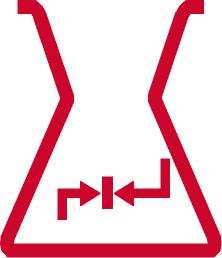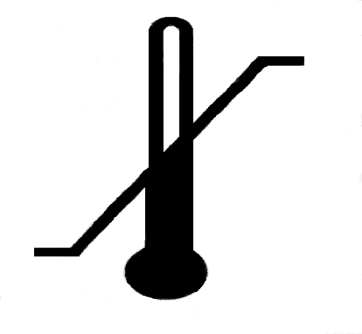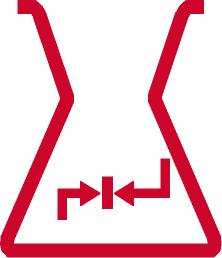Rapidtest.com


DIAGNOSTIC AUTOMATION, INC.
23961 Craftsman Road, Suite D/E/F, Calabasas, CA 91302
Tel: (818) 591-3030 Fax: (818) 591-8383
[email protected]
www.rapidtest.com
See external label
Enzyme Immunoassay for the Quantitative Determination of
Chloramphenicol in Food
Cat #5126-8
Recovery (spiked samples)
GENERAL INFORMATION
Due to its outstanding antibacterial properties, chloramphenicol is an often used antibiotic in the pro-
duction of milk, meat and eggs. In humans it leads to haematotoxic side effects (1,2), like the chloram-
phenicol induced aplastic anemia. This has caused low limits in Germany, e.g. 1 µg/kg for milk, meat
and eggs (3).
Till now the chloramphenicol concentration was determined by radioimmunoassay (4,5) or by gas chro-
matography (6). However, compared with conventional methods, enzyme immunoassays show some
essential advantages (7,8). There is no need to work with radioactive material, the required assay time
is shorter and the sensitivity is better than with chromatographic methods.
The Diagnostic Automation, Inc. Chloramphenicol test provides a rapid, sensitive and reliable assay
for the determination of chloramphenicol in food. 40 samples can be assayed in duplicate within
60 minutes.
PRINCIPLE OF THE TEST
The Diagnostic Automation, Inc. Chloramphenicol quantitative test is based on the principle of the
enzyme-linked immunosorbent assay. An antibody binding protein is coated on the surface of a micro-
titer plate. Chloramphenicol containing samples or standards and an antibody directed against
chloramphenicol are given into the wells of the microtiter plate. The chloramphenicol contained in
samples or standards will bind to the antibody which reacts with the binding protein coated onto the
microtiter plate. After 30 minutes incubation at room temperature a chloramphenicol-peroxidase
conjugate is added into the wells without a preceding washing step to saturate free antibody binding
sites. After additional 15 minutes incubation at room temperature the wells are washed with diluted
washing solution to remove unbound material. A substrate solution is added and incubated for
15 minutes, resulting in the development of a blue colour. The colour development is inhibited by the
addition of a stop solution, and the colour turns yellow. The yellow colour is measured photometrically
at 450 nm. The concentration of chloramphenicol is indirectly proportional to the colour intensity of the
test sample.
PRECAUTIONS
Full compliance of the following good laboratory practices (GLP) will determine the reliability of the results: 1. Prior to beginning the assay procedure, bring all reagents to room temperature (20-25°C). 2. All reagents should be mixed by gentle inversion or swirling prior to use. Do not induce foaming. 3. Once the assay has been started, all subsequent steps should be completed without interruption and within the recommended time limits. 4. Replace caps in all the reagents immediately after use. Do not interchange vial stoppers. 5. Use a separate disposable tip for each specimen to prevent cross-contamination. 6. All specimens and standards should be run at the same time, so that all conditions of testing are the same. 7. Do not mix components from different batches. 8. Do not use reagents after expiration date. 9. Check both precision and accuracy of the laboratory equipment used during the procedure (micro pipets, ELISA reader etc.).
HEALTH AND SAFETY INSTRUCTIONS
1. Do not smoke or eat or drink or pipet by mouth in the laboratory. 2. Wear disposable gloves whenever handling patient specimens. 3. Avoid contact of substrate and stop solution with skin and mucosa (possible irritation, burn or toxicity hazard). In case of contact, rinse the affected zone with plenty of water. 4. Handling and disposal of chemical products must be done according to good laboratory practices (GLP).
The kit contains reagents for 96 determinations. They have to be stored at 2-8°C. Expiration data are found on the labels of the bottles and the outer package. 1. Microtiter plate consisting of 12 strips with 8 breakable wells each, coated with an antibody binding protein. 2. Chloramphenicol Standards (0; 0.05; 0.1; 0.5; 1; 5 ng/mL): 6 vials with 1 mL each, dyed red, ready- to-use.
3. Anti-Chloramphenicol Antibody (sheep): 6 mL, dyed red, ready-to-use. 4. Conjugate (Chloramphenicol-Peroxidase): 6 mL, dyed red, ready-to-use. 5. Substrate Solution (TMB): 15 mL, prestained red, ready-to-use. 6. Stop Solution (0.5 M H2SO4): 15 mL, ready-to-use. 7. Sample Diluent (PBS): 2 x 60 mL, dyed red, ready-to-use. 8. Washing Solution (PBS + Tween 20): 60 mL as 10x concentrate, dyed blue. Dilute 1+9 with distilled water. If during the cold storage crystals precipitate, the concentrate should be warmed up to 37°C for 15 minutes. 9. Two plastic foils to cover the strips during the incubation. 10. Plastic bag to store unused microtiter strips. 11. Instruction Manual.
ADDITIONAL INSTRUMENTATION AND REAGENTS
(not provided)
50, 100, 500 and 1000 µL-micropipets
ELISA reader (450 nm)
Ultra-Turrax, mixer
Double distilled water
Potassiumhexacyanoferrate(II)-3-hydrate (150 g/L; Carrez I)
Zincsulfate-7-hydrate (300 g/L; Carrez II)
SAMPLE PREPARATION
Milk (direct assay)
� Refrigerate fresh milk samples at 2-8°C and centrif uge afterwards at 3000 g for 10 minutes. � Remove the upper fat layer and test the sample directly in the ELISA after warming to room tem-
perature. For skimmed milk samples the centrifugation step can be omitted.
� Sample dilution factor: F=1
Milk (Ethyl acetate extraction)
� Add 250 µL Carrez I to 5 mL milk sample, mix well and add 250 µL Carrez II afterwards. � Mix sample, refrigerate to 2-8°C and centrifuge at 3000 g for 10 minutes. � Transfer 4.4 mL of the clear supernatant to a clean glass vial, add 8 mL ethyl acetate and agitate
vigorously for 10 minutes.
� For phase separation centrifuge for 10 minutes at 3000 g (room temperature). � Transfer 4 mL of the upper ethyl acetate phase to a clean glass vial and evaporate the solvent at 50-
70°C under a nitrogen stream to dryness.
� Dissolve the dry residue with 400 µL sample diluent by shaking vigorously and test the sample in the
� Sample dilution factor: F=0.2
� Dissolve 2 g honey in 4 mL double distilled water. � Add 4 mL ethyl acetate and agitate vigorously for 10 minutes. � Transfer 1 mL of the upper ethyl acetate phase to a clean glass vial and evaporate the solvent at 50-
70°C under a nitrogen stream to dryness.
� Dissolve the dry residue with 500 µL sample diluent by shaking vigorously and test the sample in the
� Sample dilution factor: F=1
Shrimps, Meat, Fish Meal
� Mill and homogenize sample with an appropriate device (mixer, ultra-turrax). � Mix 3 g sample with 3 mL double distilled water, add 6 mL ethyl acetate and agitate vigorously for 10
� For phase separation centrifuge for 10 minutes at 3000 g (room temperature). � Transfer 4 mL of the upper ethyl acetate phase to a clean glass vial and evaporate the solvent at 50-
70°C under a nitrogen stream to dryness.
� Add 1 mL n-hexane to the residue. � Add 500 µL sample diluent to the mixture and agitate vigorously for 1 minute. � For phase separation centrifuge for 10 minutes at 3000 g (room temperature). � Test the lower, aqueous phase in the ELISA. � Sample dilution factor: F=0.25
Whole Egg (raw)
� Homogenize sample with an appropriate device (mixer, ultra-turrax). � To 2 g sample add 12 mL ethyl acetate and agitate vigorously for 10 minutes. � For phase separation centrifuge for 10 minutes at 3000 g (room temperature). � Transfer 6 mL of the upper ethyl acetate phase to a clean glass vial and evaporate the solvent at 50-
70°C under a nitrogen stream to dryness.
� Add 1 mL n-hexane to the residue. � Add 1 mL sample diluent to the mixture and agitate vigorously for 1 minute. � For phase separation centrifuge for 10 minutes at 3000 g (room temperature). � Test the lower aqueous phase in the ELISA. � Sample dilution factor: F=1
1. Prepare samples as described above. 2. Pipet 100 µL standards or prepared samples in duplicate into the appropriate wells of the microtiter plate. Immediately add 50 µL anti-chloramphenicol antibody into each well. 3. Cover the microtiter plate with a plastic foil and incubate for 30 minutes at room temperature. 4. Without preceding washing add 50 µL chloramphenicol-peroxidase conjugate into each well. 5. Cover the microtiter plate with a plastic foil and incubate additional 15 minutes at room temperature. 6. Wash the plate three times as follows: Discard the contents of the wells (dump or aspirate). Pipet 300 µL of diluted washing solution into each well. After the third repetition empty the wells again and remove residual liquid by striking the plate against a paper towel. The wash procedure is critical. Insufficient washing will result in poor precision and falsely elevated absorbencies. 7. Pipet 100 µL of substrate solution into each well. 8. Allow the reaction to develop in the dark (e.g. cupboard or drawer; the chromogen is light-sensitive) for 15 minutes at room temperature. 9. Stop enzyme reaction by adding 100 µL of stop solution (0.5 M H2SO4) into each well. The blue color will turn yellow upon addition.
10. After thorough mixing, measure absorbance at 450 nm (reference wavelength 620 nm), using an ELISA reader. The colour is stable for 30 minutes.
CALCULATION OF RESULTS
1. Calculate the average optical density (OD 450 nm) for each set of reference standards or samples.
2. Construct a standard curve by plotting the mean optical density obtained for each reference
standard against its concentration in ng/mL on semi-log graph paper with the optical density on the
vertical (y) axis and the concentration on the horizontal (x) axis.
3. Using the mean optical density value for each sample, determine the corresponding concentration
of chloramphenicol in ng/mL from the standard curve. Depending on experience and/or the avail
ability of computer capability, other methods of data reduction may be employed.
4. The diluted samples must be further converted by the appropriate sample dilution factor. The
factors are listed for each sample matrix in the sample preparation section.
Note: Due to the extraction with ethyl acetate negative samples may show a certain blank value.
In repetitive performed experiments with negative samples for each matrix the following blank
values were identified.
Milk (direct assay)
Milk (ethyl acetate extraction)
These values are defined as the cut-off of the method for the respective matrices. Lower
concentrations have to be considered as negative.
TYPICAL STANDARD VALUES
The following table contains an example for a typical standard curve. The binding is calculated as percent of the absorption of the 0 ng/mL standard. These values are only an example and should not be used instead of the standard curve which has to be measured in each new test.
Chloramphenicol (ng/mL)
% binding of 0 ng/mL
The sensitivity of the Diagnostic Automation, Inc. Chloramphenicol test is 0.03 ng/mL (based on the
standard curve).

Milk (direct assay)
Milk (ethyl acetate extraction)
Intra-assay Precision
The intra-assay variation of the chloramphenicol test was determined to 8%.
Cross-reactivity relative to chloramphenicol (=100%)
Chloramphenicol Base
1. Skarandies, G., Hausmann, K.: Knochenmarkschädigung nach Chloramphenicol-Behandlung in Hamburg und Umgebung; Med. Klin. 67, 569 (1972). 2. Schmid, A.: Chloramphenicolrückstände in Lebensmitteln tierischer Herkunft als potentielle Ursache der aplastischen Anämie des Menschen; Dtsch. tierärztl. Wschr. 90, 201 (1983). 3. Bundesgesundheitsblatt: Verordnung über Stoffe mit pharmakologischer Wirkung; BGBL. I, 1251 (1984). 4. Arnold, D. et al: Radioimmunologische Bearbeitung von Chloramphenicol-Rückständen in Mus kulatur, Milch und Eiern; Archiv Lebensmittelhyg. 35, 131 (1984). 5. Arnold, D., Somogyi, A.: Trace analysis of Chloramphenicol residues in eggs, milk and meat: comparison of gas chromatography and radioimmunoassay; J. AOAC 68, 984 (1985). 6. Bergner-Lang, B., Kächele, M.: Schnellmethode zur gaschromatographischen Bestimmung von Chloramphenicol in Milch; Deut. Lebensm. Rundschau 81, 278 (1985). 7. Märtlbauer, E., Terplan, G.: Ein enzymimmunologischer Nachweis von Chloramphenicol in Milch; Archiv Lebensmittelhyg. 38, 3 (1985).
Date Adopted
Reference No.
2010-02-11
DIAGNOSTIC AUTOMATION, INC.
23961 Craftsman Road, Suite D/E/F, Calabasas, CA 91302
Tel: (818) 591-3030 Fax: (818) 591-8383
ISO 13485-2003
Revision Date: 12-6-2013
Source: http://www.rapidtest.com/pdf/Chloramphenicol%20In%20Food%205126-8(12-6-2013).pdf
CONTRAST MEDIA TUTORIAL Jessica B. Robbins, MD Myron A. Pozniak, MD For questions, comments, or permission to use any or all of this tutorial, please or 608/263-8312 University of Wisconsin, Department of Radiology, Madison, WI © 2010 Portions of this information are reprinted with permission of the American College of Radiology.
Boletín Apícola Nº 20 – Abril 2002 El presente Boletín es elaborado trimestralmente por laDirección de Industria Alimentaria de la SAGPyA y cuentacon la colaboración de los técnicos del Proapi- INTA y delSENASA. información: Coordinación General. SAG información: Coordinación General. SAG yA: In yA: I g. Mercedes Nimo- Téc. Andrea Janin: e-mail:



